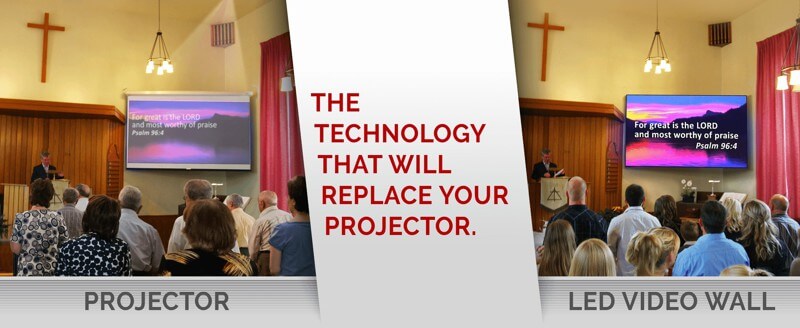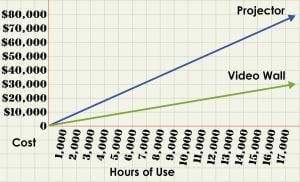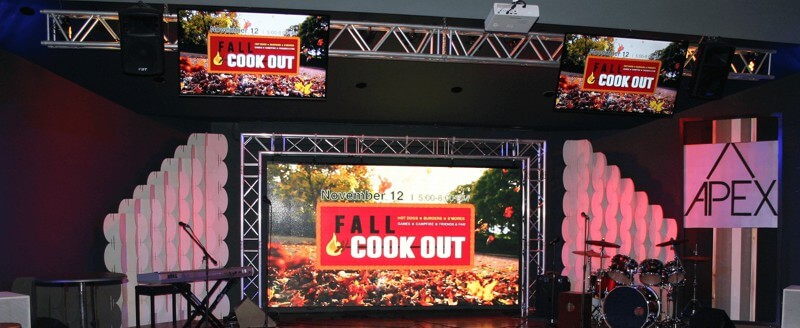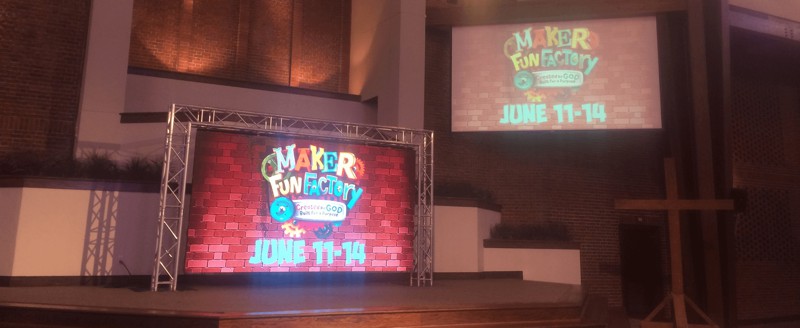More and more, organizations are discovering the power of indoor LED video walls to create engaging multi-media presentations. This new technology will give your facility the "wow factor" to entertain and engage any audience. In the long term, you'll also find that video walls tend to be lower cost, more reliable and more versatile than a traditional projection system. Here are some of the benefits you should expect with an indoor LED video wall.
Brightness & Contrast
Simply put, there is no contest when comparing brightness and contrast between LED video walls and projection systems. As the surface of the video wall itself emits the light you see, colors are more vibrant and light more brilliant. This is important because the amount of ambient light and distance from the audience can affect the quality of the image they see. Perception of brightness is also non-linear, which means that you need much more than twice the actual brightness to make an image appear twice as bright. So how can you compare brightness between an LED video wall and a projection system?

The brightness of an LED video wall is measured by the maximum luminance (brightness) of a one square meter section of the LED display. This unit of measurement is called a nit. With a rating of 2,000 nits for our video walls, your display will be capable in any kind of lighting environment. Comparing it to the brightness of a projector is not so straightforward. The overall maximum brightness of the projector bulb is measured in lumens. As the projector gets farther away from the surface it is projecting on, the brightness per square meter decreases (think of this as the same amount of light spread over a larger area). The color and reflectivity of the surface also influence how much light is bounced back to the viewer. Because of this, the equivalent "nit rating" of a projector depends on its lumen output, as well as the distance from and materials of the projection surface.
Even with a perfectly white surface, in order to illuminate an area the size of our most popular video wall (6'3? x 11'7?) at 2,000 nits, you would need a projector with an output of over 43,000 lumens!* This is more than eight times the brightness of most "large venue" front projectors that cost many tens of thousands of dollars. This light is also not evenly distributed, as the center of a projected image is typically the brightest, with the light decreasing towards the edges and corners. The contrast (difference between dark and light areas) is directly related to brightness. As the ambient light increases, the image source must be brighter to avoid becoming "washed out".
Parts & Servicing
Projector bulbs are typically rated from 3,000 to 10,000 hours of life, depending on the model and brightness settings. These bulbs emit an enormous amount of heat and will often burn out at inconvenient times. Most are very expensive to replace, and have a limited "shelf life" even when not in use. Dust and dirt can accumulate on projector lenses and filters, requiring routine maintenance. Even small variations in temperature and moisture can significantly shorten product life, as can turning off and on the projector in quick succession. Many internal components cannot be self-serviced and require expensive certified technicians to fix.
In contrast, LED video walls are intended as zero maintenance products with no parts needing routine replacement. The LEDs themselves are rated for 100,000 hours of use (over 11 years at constant full brightness). Heat generation is minimal and components are not sensitive to most indoor temperature and moisture conditions. In the unlikely event that a part should fail, servicing can be done by anyone that can use basic tools such as a screwdriver.

Footprint
Both front and rear projection systems require clear line-of-sight to their screens. Depending on the type and mounting location of the projector, this area can be large and becomes unusable for other purposes. Unlike front projection systems, presenters and equipment can be positioned directly in front of the video wall without casting shadows or being front illuminated. Unlike rear projection systems, a video wall does not require a dedicated projection room behind the screen.
A Word on Resolution
The number of pixels (discrete points of light) of an LED display will typically be less than that of a high-definition projector. While we can make any size display, our standard 480 pixel high model is less than half the pixel height of a 1080p projector. However, again the distance to the audience comes into play. Imagine looking at a high-definition TV from five feet away versus from 50 feet away. At larger distances, the amount of detail in the image is no longer discernable. Instead, the size of the screen and its brightness become much more important. Speak with a representative to determine the resolution you will require for your video wall.


* Determining luminance required for a reflective nit rating can be done with the formula (nits * meters² * ? / rf = lumens, where rf is the reflection factor from 0 (black) to 1 (white). Our 6'3? x 11'7? video wall equates to a total screen area of 6.89m². Assuming a perfectly white surface, a surface area of 6.89 square meters and a target of 2000 nits, the formula becomes (2000 * 6.89 * 3.14) / 1 = 43,269 lumens
